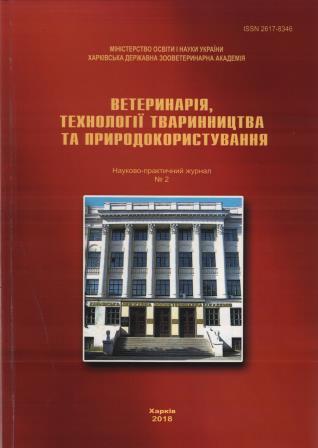Сучасні уявлення про методи кріоконсервування еритроцитів тварин
Анотація
Кріоконсервування еритроцитів тварин дозволяє зберігати та отримувати якісні клітини для використання в ветеринарній практиці. В статті представлено огляд літератури стосовно кріопошкоджень при низькотемпературному впливі, кріопротекторів, які використовуються при зберіганні клітин у рідкому азоті, а також існуючим методам кріоконсервування.
Завантаження
Посилання
Agar, N. S., & Board, P. G. (1983). Red blood cells of domestic mammals . New York: Elsevier Science Publishers.
Aktaran, B. D., & Özcan, M. (2016). The effects of freezing on long-term storage of canine erythrocytes. Pol J Vet Sci, 19, 401-406. Retrieved from https://content.sciendo.com/view/journals/pjvs/19/2/article-p401.xml.
Contreras, T. J., Lindberg, J. R., Lowrie, G. B., & et al. (1979). Liquid and freeze-preservation of dog red blood cells. Transfusion, 19, 279-292.
Denisova, O. N., Zhegunov, G. F., & Babijchuk, L. A. (2005). Kriokonservirovanie e`ritrocitov zhivotny`x pod zashhitoj dimetilsul`foksida, polie`tilenoksida, glicerina. Problemy` kriobiologii, 2, 195-201. Retrieved from http://nbuv.gov.ua/UJRN/KrioBiol_2005_15_2_11 (in Ukranian).
Denysova, O. M. (2006). Krіochutlyvіst erytrotsytіv rіznykh vydіv ssavtsіv. (Master's thesis). Іnstytut problem krіobіolohіi і krіomedytsyny NAN Ukrainy, Kharkіv (in Ukranian).
Feldman, B. F., & Kristensen, A. T. (1995). Modern veterinary blood banking practices and their applications in companion animal practice. Vet Clin North Am Small Anim Pract, 25, 1231-1243.
Graham, J. E., Meola, D. M., Kini, N. R., & Hoffman, A. M. (2015). Comparison of the effects of glycerol, dimethyl sulfoxide, and hydroxyethyl starch solutions for cryopreservation of avian red blood cells. Send to Am J Vet Res, 76, 487-493. Retrieved from https://avmajournals.avma.org/doi/pdf/10.2460/ajvr.76.6.487.
Kaufman, P. M. (1992). Supplies for blood transfusions in dogs and cats. Probl. Vet. Med., 4, 582–593.
Kim, H., Tanaka, S., Une, S., & et al. (2004). A comparative study of the effects of glycerol and hydroxyethyl starch in canine red blood cell cryopreservation. J Vet Med Sc., 66, 1543-1547. Retrieved from https://www.jstage.jst.go.jp/article/jvms/66/12/66_12_1543/_pdf/-char/en.
Kim, H., Itamoto, T., Une, S., & et al. (2005). Application of phosphoenolpyruvate into canine red blood cell cryopreservation with hydroxyethyl starch. Cryo Letters, 26, 1-6.
Lovelock , J. E. (1953). The mechanism of the protective action of glycerol against haemolysis by freezing and thawing. Biochim Biophys Acta,11, 28-36.
Lovelock, J. E., & Bishop, M. W. (1959). Prevention of freezing damage to living cells by dimethyl sulphoxide. Nature, 183, 1394-1395.
Liu, Y., Promeneur, P., Rojek, A., & et al. (2007). Aquaporin 9 is the major pathway for glycerol uptake by mouse erythrocytes, with implications for malarial virulence. Proc Natl Acad Sci U S A., 104, 12560-12564. Retrieved from https://www.ncbi.nlm.nih.gov/pmc/articles/PMC1941508/ .
Mazur, P. (1963). Kinetics of Water Loss from Cells at Subzero Temperatures and the Likelihood of Intracellular Freezing. The Journal of General Physiology, 10, 347-369. Retrieved from http://jgp.rupress.org/content/47/2/347.long.
Mazur, P., Miller, R. H., & Leibo, S. P. (1974). Survival of frozen-thawed bovine red cells as a function of the permeation of glycerol and sucrose. J Membr Biol, 15, 137-158.
Mazur, P., Leibo, S.P., & Chu, E.H. (1972). A two-factor hypothesis of freezing injury. Evidence from Chinese hamster tissue-culture cells . Exp Cell Res, 72, 345-35.
Meryman , H. T. (1960). General principles of freezing and freezing injury in cellular materials. Ann N Y Acad Sci, 85, 503-509.
Obrador, R., Musulin, S., Hansen, B. (2015). Red blood cell storage lesion. J. Vet. Emerg. Crit. Care. (San Antonio), 25, 187–199.
Pervushina, O. A., Zhegunov, G. F., & Denisova, O. N. (2014). Vliyanie kriokonservirovaniya na soxrannost` i osmoticheskuyu xrupkost` e`ritrocitov domashnix zhivotny`x. Problemi zooіnzhenerії ta veterinarnoї medicini, 28, 408-410 (in Ukranian).
Pogozhykh, В., Pakhomova, Y., Pervushina, O., & et al. (2017). Exploring the Possibility of Cryopreservation of Feline and Canine Erythrocytes by Rapid Freezing with Penetrating and Non-Penetrating Cryoprotectants. PLoS One, 12, 1-12. Retrieved from https://journals.plos.org/plosone/article?id=10.1371/journal.pone.0169689
Pushkar`, N. E., & Belous, A. M. (1975). Vvedenie v kriobiologiyu . Kiev: Naukova dumka (in Russian).
Rapatz, G., Sullivan, J. J., & Luyet, B. (1968). Preservation of erythrocytes in blood containing various cryoprotective agents, frozen at various rates and brought to a given final temperature. Cryobiology, 5, 18-25.
Valery, C. R., Valery, D. A., Gray, A., & et al. (1983). Rhesus macaque red blood cells frozen with 40% glycerol and stored at -80 C. Send to Am J Vet Res, 44, 1786-1789.
Valery, S. R., Valery, D. A., Gray, A., & et al. (1983). Horse red blood cells frozen with 20% (w/v) glycerol and stored at -150 C for five years. Am J Vet Res, 44, 2200-2202.
Yang, B., Ma, T., & Verkman, A. (2001). Erythrocyte water permeability and renal function in double knockout mice lacking aquaporin-1 and aquaporin-3. J Biol Chem, 276, 624-626. Retrieved from http://www.jbc.org/content/276/1/624.long
Zhegunov, G. F., & Denisova, O. N. (2010). Proniczaemost` e`ritrocitov mlekopitayushhix dlya molekul glicerina i DMSO i stepen` soxrannosti kletok posle zamorazhivaniya-ottaivaniya. Dopovіdі NAN Ukraїni, 139-143. Retrieved from http://dspace.nbuv.gov.ua/bitstream/handle/123456789/31118/23-Zhegunov.pdf (in Ukranian).
Переглядів анотації: 2116 Завантажень PDF: 1162





